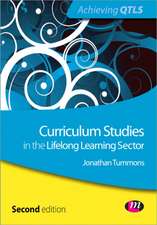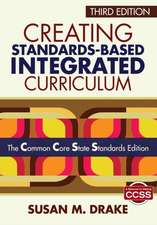Enriching Curriculum for All Students
Editat de Joseph S. Renzulli, Sally M. Reisen Limba Engleză Paperback – 8 ian 2008
| Toate formatele și edițiile | Preț | Express |
|---|---|---|
| Paperback (1) | 306.53 lei 43-57 zile | |
| SAGE Publications – 8 ian 2008 | 306.53 lei 43-57 zile | |
| Hardback (1) | 539.35 lei 43-57 zile | |
| SAGE Publications – 14 ian 2008 | 539.35 lei 43-57 zile |
Preț: 306.53 lei
Nou
Puncte Express: 460
Preț estimativ în valută:
58.65€ • 61.40$ • 48.53£
58.65€ • 61.40$ • 48.53£
Carte tipărită la comandă
Livrare economică 07-21 aprilie
Preluare comenzi: 021 569.72.76
Specificații
ISBN-13: 9781412953801
ISBN-10: 1412953804
Pagini: 192
Ilustrații: figures
Dimensiuni: 216 x 279 x 13 mm
Greutate: 0.54 kg
Ediția:Second Edition
Editura: SAGE Publications
Colecția Corwin
Locul publicării:Thousand Oaks, United States
ISBN-10: 1412953804
Pagini: 192
Ilustrații: figures
Dimensiuni: 216 x 279 x 13 mm
Greutate: 0.54 kg
Ediția:Second Edition
Editura: SAGE Publications
Colecția Corwin
Locul publicării:Thousand Oaks, United States
Recenzii
"This book does a good job explaining the purpose, design, and use of the enrichments and their relationship to the general curriculum."
"By the end of the book, I came to have a great respect for the authors' compassion and sense of social justice, which really shine through in their praxis."
"The information in the book is extremely relevant. With the current demands for educational improvement, leaders in the field are searching for new, innovative means of helping students feel connected to their schools."
"Without a doubt, this book makes a contribution to the field."
"By the end of the book, I came to have a great respect for the authors' compassion and sense of social justice, which really shine through in their praxis."
"The information in the book is extremely relevant. With the current demands for educational improvement, leaders in the field are searching for new, innovative means of helping students feel connected to their schools."
"Without a doubt, this book makes a contribution to the field."
Cuprins
Introduction
About the Authors
1. What Is "Enrichment" and Why Is It Important in Developing Curriculum in America's Schools?
The "Why" Question: Why Enrichment?
The "What" Question: What Kinds of Enrichment?
What Exactly Is Enrichment Learning and Teaching?
The Teacher Role as the Guide-on-the-Side
The Four Goals of Schoolwide Enrichment
2. Using the Schoolwide Enrichment Model to Enrich Curriculum for All Students
Introduction
Expanding Conceptions of Gifts and Talents: The Theory Underlying the SEM
Developing Two Kinds of Giftedness
An Overview of the Enrichment Triad Model
The Revolving Door Identification Model: Identifying Students for the SEM
The Schoolwide Enrichment Model (SEM)
The Regular Curriculum
The Enrichment Clusters
The Continuum of Special Services
The Service Delivery Components
The Total Talent Portfolio
Curriculum Differentiation and Compacting
Enrichment Teaching and Learning
Non-Negotiables about implementing Enrichment in the SEM
Research on the SEM
Summary
3. Challenging All Students With a Continuum of Enrichment Services
Background to the Establishment of a Continuum of Services
Theoretical and Organizational Models
An Integrated Continuum of Special Services
How and When Enrichment Activities Take Place
Keys to Developing a Comprehensive Continuum of Services
Organizing Services in the Continuum
The Role of Grouping and Tracking in a Continuum of Services
The Politics of Grouping
Nongraded Instructional Grouping and Within Classroom Cluster Grouping
Managing Within Classroom Cluster Groups
Other Enrichment Options
Summer Programs and Schools for Gifted Students
4. Developing Talent Portfolios for All Students
What Is the Total Talent Portfolio?
Status and Action Information
Focus on Strengths
Portfolio Engineering: Creating a Total Talent Portfolio
Gathering and Recording Information About Abilities
Standardized Tests and Teacher-Made Tests
Grades
Teacher Ratings
Gathering and Recording Information About Student Interests
The Interest-A-Lyzer
Individualization and the Role of Learning Styles
Instructional Styles Preferences
Learning Environment Preferences
Benefits of the Total Talent Portfolio
5. Curriculum Compacting and Differentiation
Curriculum Compacting: Definitions and Steps for Implementation
Defining Curriculum Compacting
How to Use the Compacting Process
Providing Acceleration and Enrichment Options for Talented Students
Rosa: A Sample Compactor Form
Providing Support for Teachers to Implement Compacting: The Steps in Compacting
Enrichment Materials in the Classroom
Assessing Students Interests
Interest Centers
Research on Curriculum Compacting
Advice From Successful Teachers Who Have Implemented Compacting
The Multiple Menu Model: A Guide to In-Depth Learning and Teaching
The Knowledge Menu
Locating the Discipline
Selecting Concepts and Ideas
Selecting Representative Topics
A Final Consideration: Appeal to the Imagination
The Instructional Techniques Menus
The Instructional Products Menu
Interdisciplinary Models
Summary
6. Enrichment Learning and Teaching: The Enrichment Triad Model
An Overview of the Enrichment Triad Model and Student Creative Productivity
Learning in a Natural Way
The Importance of Interaction
Type I Enrichment: General Exploratory Experiences
Type II Enrichment: Group Training Activities
Type III Enrichment: Individual and Small Group Investigations of Real Problems
Applying the Enrichment Triad Model to Enrichment Clusters
How Can Teachers Learn to Use Enrichment Teaching?
Applying the Type III Process to Enrichment Clusters
7. Applying the Schoolwide Enrichment Model to Content Areas: The SEM in Reading
Phase 1: Hooking Kids on Literature With Teacher Read-Alouds
Phase 2: Supported Independent Reading and Differentiated Conferences
Phase 3: Interest and Choice Activities
Research on the SEM-R
8. A Dozen Assistants In Your Classroom Implementing SEM by Using a New Online Resource for Enrichment and Differentiation
Step 1: Strength Assessment Using the Electronic Learning Profile (The Total Talent Portfolio Online)
Step 2: Enrichment Differentiation Databases
Step 3: The Wizard Project Maker
Step 4: The Total Talent Portfolio
Renzulli Learning System
The Value-Added Benefits of Learning With Technology
Renzulli Learning: Conclusions
References
Index
About the Authors
1. What Is "Enrichment" and Why Is It Important in Developing Curriculum in America's Schools?
The "Why" Question: Why Enrichment?
The "What" Question: What Kinds of Enrichment?
What Exactly Is Enrichment Learning and Teaching?
The Teacher Role as the Guide-on-the-Side
The Four Goals of Schoolwide Enrichment
2. Using the Schoolwide Enrichment Model to Enrich Curriculum for All Students
Introduction
Expanding Conceptions of Gifts and Talents: The Theory Underlying the SEM
Developing Two Kinds of Giftedness
An Overview of the Enrichment Triad Model
The Revolving Door Identification Model: Identifying Students for the SEM
The Schoolwide Enrichment Model (SEM)
The Regular Curriculum
The Enrichment Clusters
The Continuum of Special Services
The Service Delivery Components
The Total Talent Portfolio
Curriculum Differentiation and Compacting
Enrichment Teaching and Learning
Non-Negotiables about implementing Enrichment in the SEM
Research on the SEM
Summary
3. Challenging All Students With a Continuum of Enrichment Services
Background to the Establishment of a Continuum of Services
Theoretical and Organizational Models
An Integrated Continuum of Special Services
How and When Enrichment Activities Take Place
Keys to Developing a Comprehensive Continuum of Services
Organizing Services in the Continuum
The Role of Grouping and Tracking in a Continuum of Services
The Politics of Grouping
Nongraded Instructional Grouping and Within Classroom Cluster Grouping
Managing Within Classroom Cluster Groups
Other Enrichment Options
Summer Programs and Schools for Gifted Students
4. Developing Talent Portfolios for All Students
What Is the Total Talent Portfolio?
Status and Action Information
Focus on Strengths
Portfolio Engineering: Creating a Total Talent Portfolio
Gathering and Recording Information About Abilities
Standardized Tests and Teacher-Made Tests
Grades
Teacher Ratings
Gathering and Recording Information About Student Interests
The Interest-A-Lyzer
Individualization and the Role of Learning Styles
Instructional Styles Preferences
Learning Environment Preferences
Benefits of the Total Talent Portfolio
5. Curriculum Compacting and Differentiation
Curriculum Compacting: Definitions and Steps for Implementation
Defining Curriculum Compacting
How to Use the Compacting Process
Providing Acceleration and Enrichment Options for Talented Students
Rosa: A Sample Compactor Form
Providing Support for Teachers to Implement Compacting: The Steps in Compacting
Enrichment Materials in the Classroom
Assessing Students Interests
Interest Centers
Research on Curriculum Compacting
Advice From Successful Teachers Who Have Implemented Compacting
The Multiple Menu Model: A Guide to In-Depth Learning and Teaching
The Knowledge Menu
Locating the Discipline
Selecting Concepts and Ideas
Selecting Representative Topics
A Final Consideration: Appeal to the Imagination
The Instructional Techniques Menus
The Instructional Products Menu
Interdisciplinary Models
Summary
6. Enrichment Learning and Teaching: The Enrichment Triad Model
An Overview of the Enrichment Triad Model and Student Creative Productivity
Learning in a Natural Way
The Importance of Interaction
Type I Enrichment: General Exploratory Experiences
Type II Enrichment: Group Training Activities
Type III Enrichment: Individual and Small Group Investigations of Real Problems
Applying the Enrichment Triad Model to Enrichment Clusters
How Can Teachers Learn to Use Enrichment Teaching?
Applying the Type III Process to Enrichment Clusters
7. Applying the Schoolwide Enrichment Model to Content Areas: The SEM in Reading
Phase 1: Hooking Kids on Literature With Teacher Read-Alouds
Phase 2: Supported Independent Reading and Differentiated Conferences
Phase 3: Interest and Choice Activities
Research on the SEM-R
8. A Dozen Assistants In Your Classroom Implementing SEM by Using a New Online Resource for Enrichment and Differentiation
Step 1: Strength Assessment Using the Electronic Learning Profile (The Total Talent Portfolio Online)
Step 2: Enrichment Differentiation Databases
Step 3: The Wizard Project Maker
Step 4: The Total Talent Portfolio
Renzulli Learning System
The Value-Added Benefits of Learning With Technology
Renzulli Learning: Conclusions
References
Index
Descriere
230876














